Archive for category January 2020
The Annual Writers’ Dinner
Posted by admin in January 2020, Past issues on February 20, 2020
By Premlata Venkataraman
This was a valid point. The magazine is meant to be a platform for disseminating information about ourselves to readers scattered around Pittsburgh. We have been doing this for 24 years. Also, this magazine is mailed to many media outlets in Pittsburgh, local libraries, and offices of elected officials. So, we are eager to highlight events in our community.The Patrika can address this with help from the organizers of these events.
But here is the challenge: The Indian population here is thinly scattered over a large area around Pittsburgh and its Metro neighborhood. It is difficult for any one or two people to go to these events to cover these programs. Remember, these people have their own family obligations and social life in addition to holding full-time jobs.
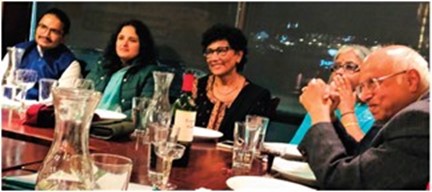
One point many raised was the lack of coverage of the social and cultural programs our readers organize in the eight-county tri-state region of south-western Pennsylvania, Eastern Ohio and the West Virginia Panhandle. The magazine should highlight these events to reach the wider audience of the Patrika.
One possible solution, however: if the organizers of these programs alert us in advance about the events, the Patrika can publicize these events. As a matter of fact, in every issue, we place a boxed item as shown below with red letter caption to draw readers’ attention to this very point. This point was acknowledged by a few among the participants.
We welcome more stories on any topic that interests or provokes them and make this annual event lively. END ï®
Home:
Indian Dances in the Pittsburgh’s Annual Thanksgiving/Holiday Parade
Posted by admin in January 2020, Past issues on February 20, 2020
By Nandini Mandal
Artistic Director, Nandanik School of Dances
On November 30 at 9 AM history was made for the Indian community in Pittsburgh. For the first time, the organizers of the annual WPXI Holiday Parade invited us for the annual outside gala. Having seen our performance at Market Square on 13th and 27th September as part of Welcome Pittsburgh, they invited us to participate in the Thanksgiving weekend in 2019.
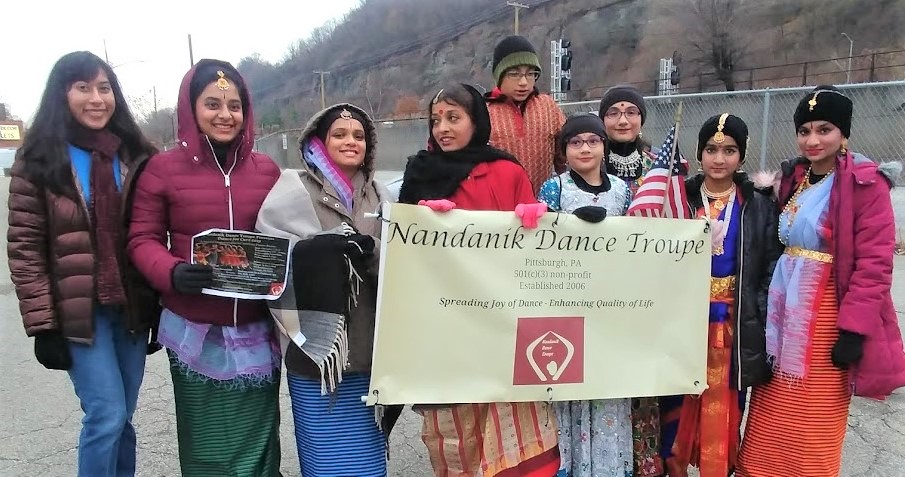
Excited as we all were, we were also worried about the weather. Our Indian dance costumes are meant for the tropical and subtropical weather, so it was a challenge to design our costumes for the outside event in the cold weather. We decided to gear up in outdoor sport wear underneath our Bharatanatyam, Koli, Garba, and Manipuri costumes!
Sixteen dancers participated along with their enthusiastic parents. We gathered at 7:00 am in Strip District braving the subfreezing temperatures. The wind chill was 20 degrees and the mercury was at 30 F, but nothing could dampen our spirits. There were drummers, marching bands, fire brigade, canine troops, and other organizations of this wonderful city and Allegheny County.
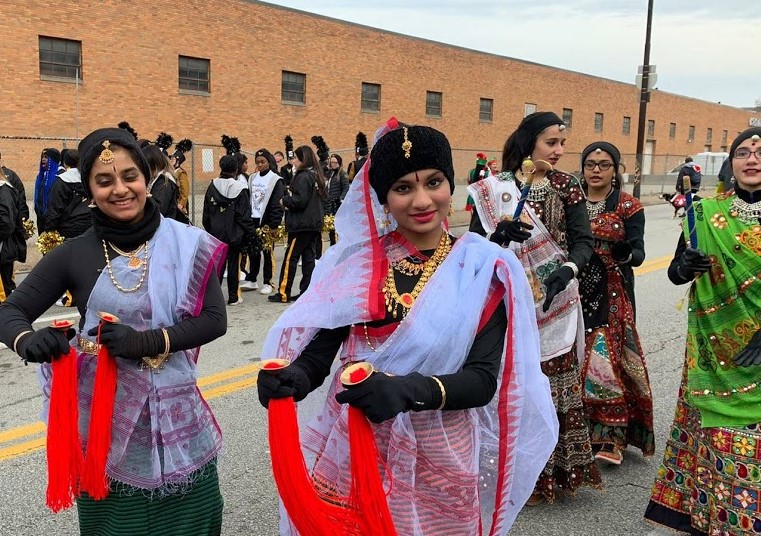
It was a two-mile walk. A crowd had gathered, braving the cold and cheering us along the way. Little children from among the bystanders danced along with us. The fun part was to see ourselves on the big screen and the reporters talking about us on live TV!
For the first time, India was part of the annual gala. We were delighted that the minority Indian-American community was appreciated by all. We contributed in our own way to become part of the American mainstream.
Anushka Sharma, a seventh grader from Upper Saint Clair, said this on her participation: “It was an amazing to perform and share different Indian classical dances with people from my home city. I was happy to get this experience, because we don’t always have a chance to share our Indian culture with people from other cultures.â€
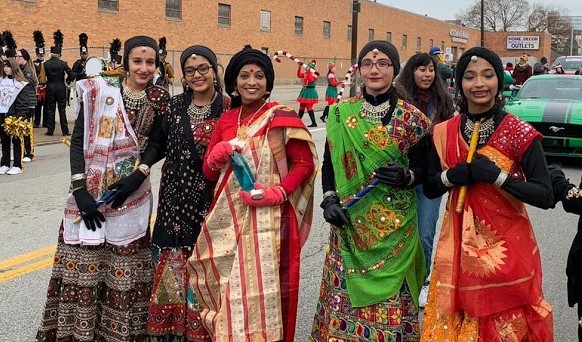
Aditi Thakur, a tenth grader also from the same area said, “The experience overall was fun, albeit a bit cold. It was amazing that we were performing there in the first place. So many people cheered us on, and I felt welcome while performing something from my heritage. In true thanksgiving spirit, I felt connected to the Pittsburgh community and I’m grateful that I got to share my culture with my community.â€
Please mark your calendars for our spring production. VILAYA — The Confluence Festival of Indian classical dances on April 18 and 19 at Andrew Carnegie Free Library & Music Hall at Carnegie. This will be the third year of the festivities as we continue in our mission to promote the rich heritage of Indian art in the greater Pittsburgh region. END ï®
Home:
A Divine Sitar Concert in Pittsburgh by Ustad Shahid Parvez Khan
Posted by admin in January 2020, Past issues on February 20, 2020
By Priyadarshan Manohar, Squirrel Hill, PA

Editor’s Note: Dr. Priyadarshan Manohar has been interested in music for a long time through his association with Marathi musical theater. He has written and produced a few musical plays and created some singing shows for the Pittsburgh community. He has studied Tabla for some time.
What do you get when you combine the culmination of six generations of professional sitar playing heritage and one of India’s most talented artists known for vocalist phrasing of raga improvisation? The answer, Ustad Shahid Parvez Khan. It was a divine evening at Chatham University’s Eddy Theater on Saturday, September 21 when the Ustad brilliantly displayed his skills on sitar, with Pandit Samir Chaterjee accompanying him on the tabla.
Chandayan, a non-profit organization founded in Calcutta that has branches all over the world, organized the program to the delight of Pittsburgh’s Indian classical music lovers. Chandayan is dedicated to the promotion and preservation of Indian music, dance and culture.
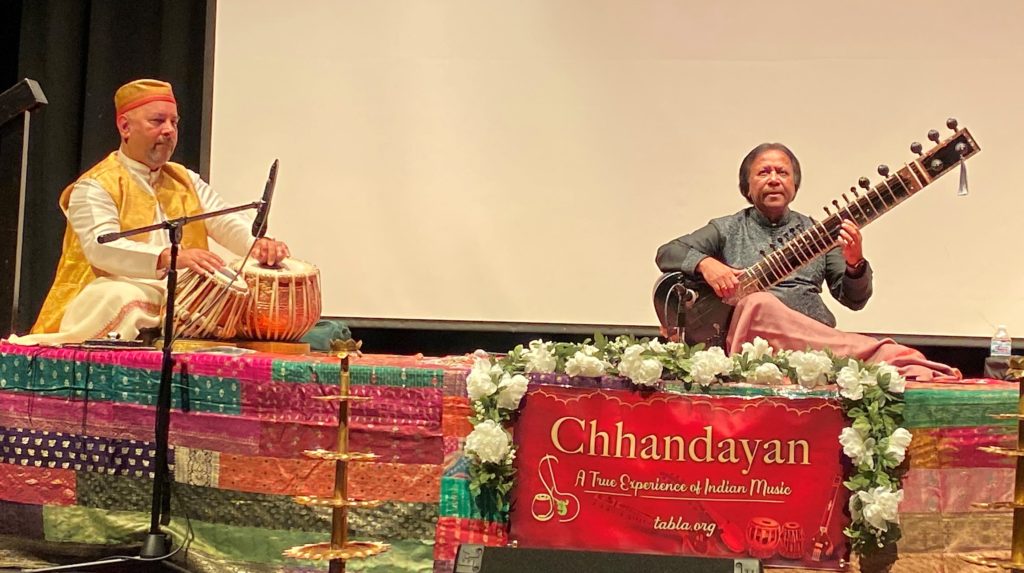
Ustad Shahid Parvez Khan, a world-renowned sitar player, is the recipient of prestigious awards including Padmashree by the Government of India. He has also received the Sangeet Natak Academy award, the most prestigious award in musical theater in India. The Ustad belongs to the seventh generation of sitar player in the Etawa Gharana. Pandit Samir Chaterjee, a wonderful artist in his own right, who has performed all over the world, is the backbone of Chandayan.
Ustad Shahid Parvez Khan started the concert with aalap in the raga Yaman in Rupak and Teentaal. He explained that raga is neither a mood nor a melody but a framework for melodically and aesthetically bringing out the mood and the emotions of the time of the day and the season of the year.
He played on the sitar with so much elegance and dexterity that at times it felt as if he was playing the beat, the notes and the words all at the same time just on his sitar.
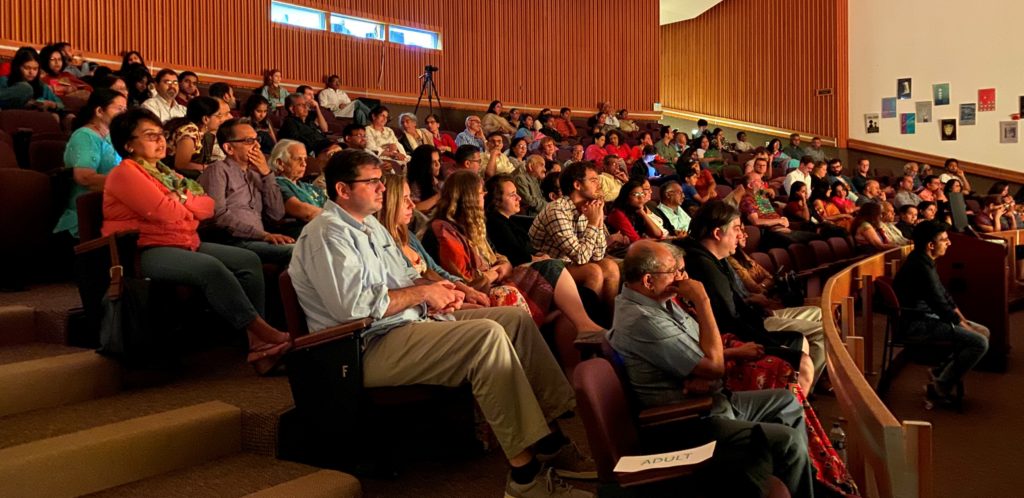
He continued his concert with jod-aalap with the tabla accompanying him. It was wonderful to hear the sitar sometimes sounding as if it was a quiet stream of water flowing, sometimes as frantic as rapids, sometimes with an abandonment and energy of a waterfall, and sometimes reflective and introverted with the depth and patience of an ocean.
Ustad Shahid Parvez presented two gats in taal Rupak and Teentaal in the second half of the concert. He played a lovely tune of the famous Hindi song Mohe Panghat Pe Nandlal based on raga Pilu. His sitar was practically singing the innermost amorous emotions of Radha for her God Shreekrishna (Nandalaal). The most delicate tunes created by the Ustad on his sitar touched the hearts of the audience.
The dhun in Khamaj was so melodious and sweet that at times it felt like a pleasant evening breeze touching the soul. Like a butterfly hovering on the flowers. Like a river joyfully meandering through a valley…and sometimes even like an enchantress walking down the red carpet who is fully aware of her grace, beauty and immaculate style.
Parvez Khan ended the concert with a mesmerizing gat in raga Desh in Ektaal. Accompaniment on tabla by Pandit Samir Chaterjee was perfectly in rhythm with the sitar music like old friends walking together, step for step enjoying each other’s company.
It was an enchanting musical experience and a great evening overall. Many thanks to Chandayan for bringing this musical feast to Pittsburgh. We look forward to attending many more concerts in town! END ï®
Home:
A Mega Kitchen Serves Hot, Nutritious Food to Thousands of School Children in Delhi
Posted by admin in January 2020, Past issues on February 20, 2020
By Srinivas Iyer, Gibsonia, PA
One summer evening in Pittsburgh I met Mr. Sanjay Tikku, Trustee and Vice Chariman of Annamrta Foundation, who is doing full-time volunteer work spearheading a mid-day meal project for students of public schools in the suburbs of New Delhi. This single mega kitchen is serving 150 government schools, serving 90,000 children every day. His Pan India organization is serving 1.2 million children per day through twenty mega kitchens in eight states.

I was so intrigued by his determination and enthusiasm that I decided to make a day trip from Mumbai to Delhi during my recent visit to India to get a first-hand experience of his work. I finished my field trip that day, returning to Delhi’s Indira Gandhi airport on my way back, I was overwhelmed, humbled and completely in awe of the well-oiled project that Mr. Tikku is running.
The mega kitchen he is managing is located in the southwest suburb of Delhi, near Ali Vihar, in a poor section of the city. Once you are inside the compound, it is spic and span, with full attention given to hygiene.
The Delhi school board gives them the menu along with the caloric value for the meals. Hot food is prepared in a timely fashion to feed the approx. 90,000 children daily.
The mega kitchen has its own delivery vans that make sure that the food is delivered on time, rain or shine! Mr. Tikku and his team have fine-tuned the entire process and have mastered the multiple variable logistics with a 100% fail-safe guarantee for delivering the lunches on time!
Mr. Tikku and team have been able to get corporate donors in the initial setup of these mega-kitchens, costing approx. US$2 million. However, the operating cost is only about Rs.2 per child per day!
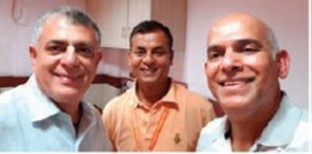
Mr. Tikku is eager to setup such mega kitchens in rural Bihar and Jharkhand, where the mid-day meal is the key factor to bringing the kids to school. Hence, his dedicated work not only provides nutrition to the next generation of India, but also is a key factor in educating them! This is a project that has implications far beyond that meets the eye.
Corporate funding is being directed to government projects such as swacch-abhiyan projects and hence is not available for the setup of Mr. Tikku’s future NGO mega kitchen projects. A US charity has been established to raise funds to setup these mega kitchens in rural India. Mr. Sanjay Tikku can be reached at: Sanjaytikku5@gmail.com END ï®
Home:
A Fascinating Scene at the Kollur Mookambika Temple
Posted by admin in January 2020, Past issues on February 20, 2020
By K S Venkataraman
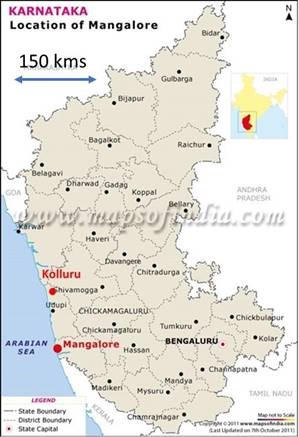
About 90 miles from the coastal city of Mangaluru in Karnataka is the famous Mookambika Temple in the Western Ghat forest. This temple has a fascinating history traceable all the way back to Adi Shankara. Devotees from all over South India, more from the neighboring Kerala State, come here to worship the presiding deity Mookambika as Saraswati, Lakshmi, and Durga. Because of this, aksharaabhyaasam, the ceremony initiating young kids into learning, is conducted all through the year. Young parents come here for this ceremony with their small children accompanied by their family elders. Last December, I was at the temple with my wife, and my elder daughter, her husband and her two kids for the ceremony for the grandkids.
Sitting with a bunch of people with their young kids, coming from diverse socioeconomic backgrounds, was uplifting. Parents and grandparents were squatting on the floor with their young wards. They knew the routine. The priest then placed in front of every child a brass plate with rice paddy spread evenly on the plate and a piece of turmeric root. He then recited Sanskrit hymns seeking divine grace for completing the ceremony of initiating the kids into studies.
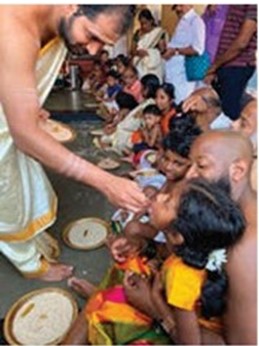
The priest then asked the father/mother/grandfather to hold the tender fingers of the young one sitting on their lap and write with the turmeric root the following: a aa, i, ii, u uu etc. — the Indian alphabets — in their native scripts like Malayalam, Tamil, Telugu, Kannada, Hindi… Then he asked the parents to write the numbers 1 to 10.
These steps made enormous sense. After all, civilizations are built around languages and mathematics. As the Good Old Tamil Grand Lady Ouvvaiyyar said over a millennia ago,

eNNum ezhuttum kaNNenattagum
meaning, “Numbers and letters are the two eyes on our face,” because they are necessary to acquire skills and make ourselves useful to others. Otherwise, we become a burden on society.
But the priest did not stop with initiating the young ones only to letters and numbers. He then did something unique and fascinating: he also asked the parents to help the kids to write sa, ri, ga, ma, pa, da, ni, the seven notes in Indian music, similar to do re mie fa solâ… …
What was the priest’s motivation for this step in the aksharaabhyaasam ceremony? He was indicating to parents that it is not enough to acquire skills to earn wealth as an end in itself, but also to cultivate interest in aesthetics like music, dance, literature… … both as practitioners and as patrons as well. After all, wealth and resources are for enjoying the finer aspects of life.
The priest conducting the ceremony himself was starkly simple in his demeanor and was by no means affluent. But he had a far better concept of how we should live our lives and use our resources. END
Home:
6th PIC-5k Run Brings the Indian Community Together Raising $60,000 for Local Causes!
Posted by admin in January 2020, Past issues on February 20, 2020
By Suresh Ramanathan, Volunteer, PIC-5k Organizers
Despite the ominous forecast, it turned to be perfect weather for runners and walkers, which later blossomed into a sunny afternoon! On Saturday, September 14, 2019, the Indian Community and Friends in all its diversity gathered at the North Park Boat House for the sixth year to celebrate the annual 5-k walkathon.
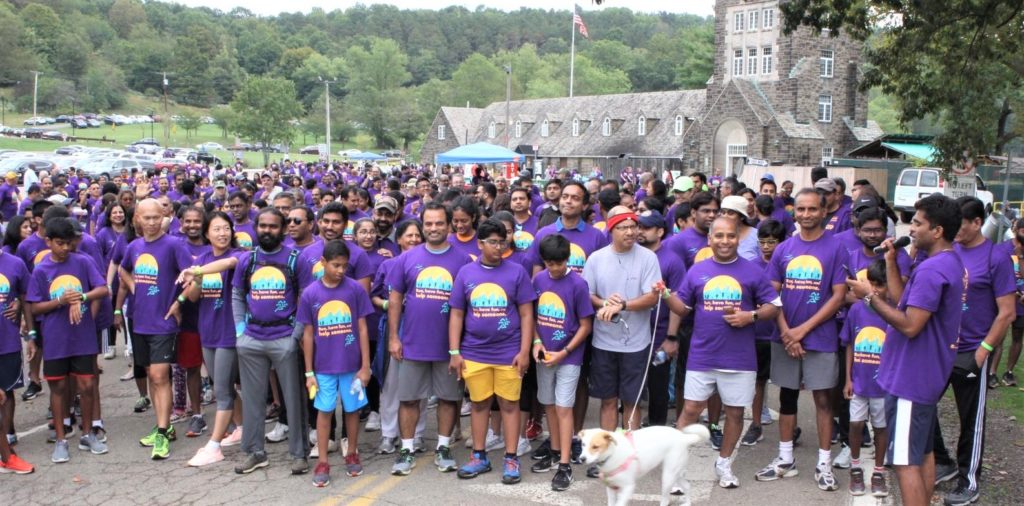
If you were one of the over 500 who attended, you probably enjoyed the ambience of the beautiful North Park Boat House area before you set off on a 5-k or 1-k walk or run around the placid lake. You may have even joined the yoga class to stretch and limber up before the national anthems began. Along the way you may have picked up a bottle of water or dawdled at the color station to create your own custom-designed purple shirt and make yourself even more colorful.
When you made your way back to the boat house you would have found bananas, clementines and piping hot Indian food waiting for you. As you listened to the results of the run and music and interacted with the various non-profits at their tables, your younger children got their faces painted or got Mehndi done for a small donation.
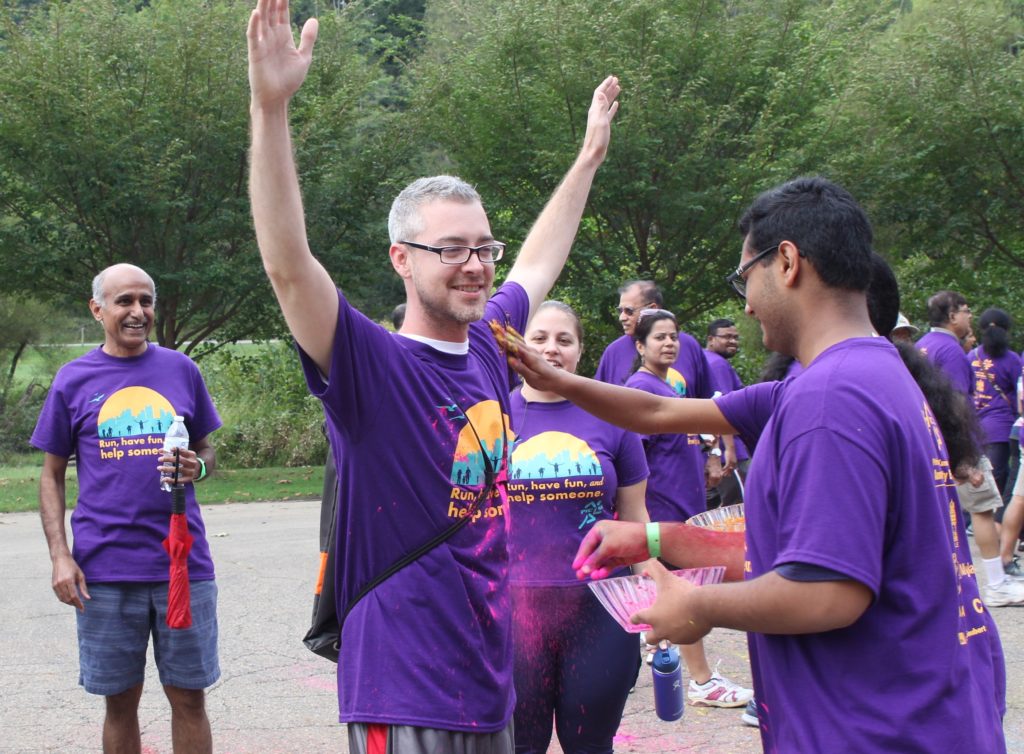
As you enjoyed the delicious food and walked around visiting various tables, you would have bought raffle tickets and dropped then into containers to win tickets to a great Indian music concert or to snag “the biker’s basket†from Pro Bike and Run or even tried your chance at winning a collection of wines. Even if you did not win any of the raffles, you went home with great memories, a striking T-shirt, knowing you came together with your community to make an investment in the lives of people in our region.
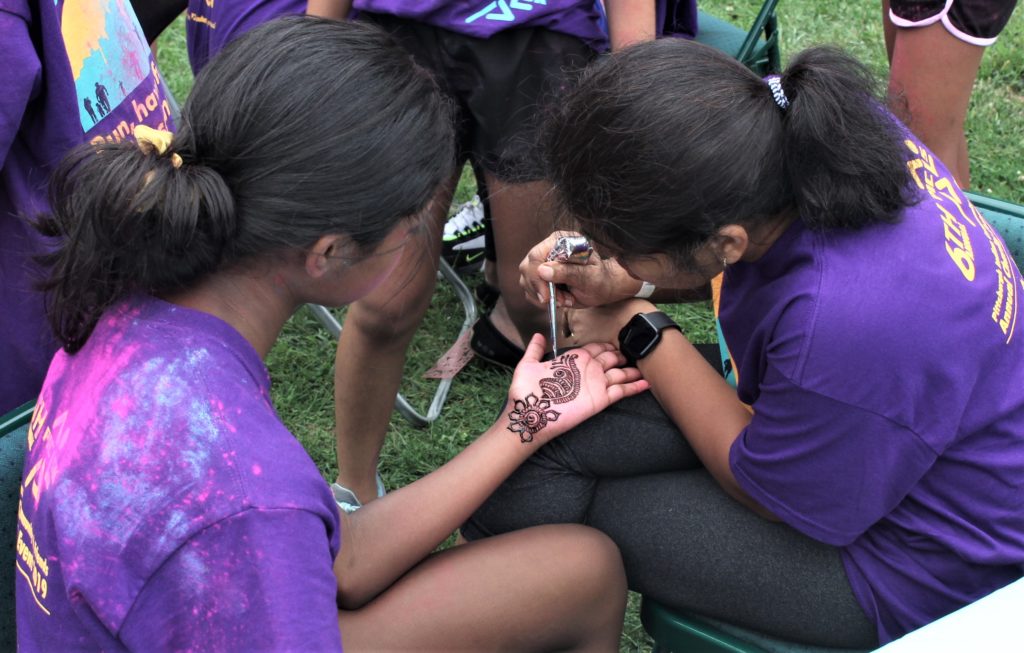
September is Hunger Action Month! The Pittsburgh Indian Community and Friends partnered with the Greater Pittsburgh Community Food Bank to support the “Breakfast Challenge†at 74 target schools across 11 counties in our region. In addition, we are partnering directly with some schools. As with other causes, this year too 100% of what is invested goes to programs, with not a red copper penny going to administrative overheads.
The PIC-5k event this year raised around $60,000. bringing the total over the 6-year period to $310,000. Over the last five years, the Pittsburgh Indian Community and Friends has invested over $260,000 in our own community in the areas of homelessness, education, healthcare and first responders. All this would not be possible without your involvement as supporters, donors, volunteers and sponsors. Thank you! END ï®
Home:
SPIFPA’s 2019 Cultural Festival
Posted by admin in January 2020, Past issues on February 20, 2020
By Radha Rao Dhulipala, Fox Chapel, PA
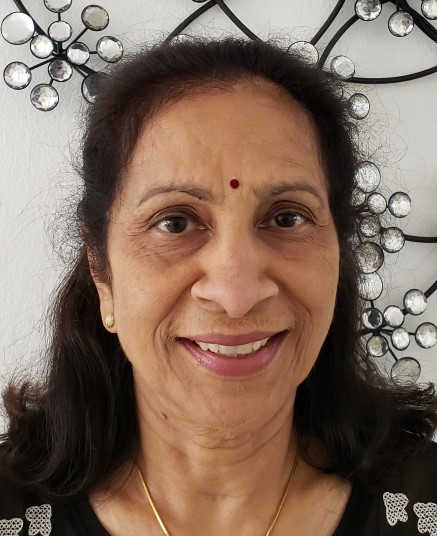
Radha Rao, a long-time resident in our area known to many, was born and raised in Chirala, a coastal town in Andhra Pradesh, India. After marrying Madhusudhan Rao, she moved to Pittsburgh in 1969. With her bachelors’ degree from Andhra University, and an MBA from Pitt, she worked at Carnegie Mellon University for 25 years. She is retired now. She volunteers at the S.V. Temple. She fondly recalls taking to Duquesne University decades ago for getting the 30-minute Music from India program on 90.5 FM.
Srinivasa Prasad International Foundation for Performing Arts (SPIFPA) hosted its 2019 Pittsburgh Cultural Festival of South Asian Performing Arts on Sunday, October 6th at the Fox Chapel Area High School Auditorium. Varaprasad and Parvathi Gutti of Latrobe, long-time residents and enthusiastic patrons of Indian performing arts for decades here, established SPIFPA as a non-profit 501 C (3) in 2005 in loving memory of Vasu (Srinivasa Prasad), their beloved son. Vasu, a passionate enthusiast of Kuchipudi and other Indian dance forms, died in a freak auto accident in 2004 and it was Vasu’s ambition to promote South Asian performing arts among North American youth.
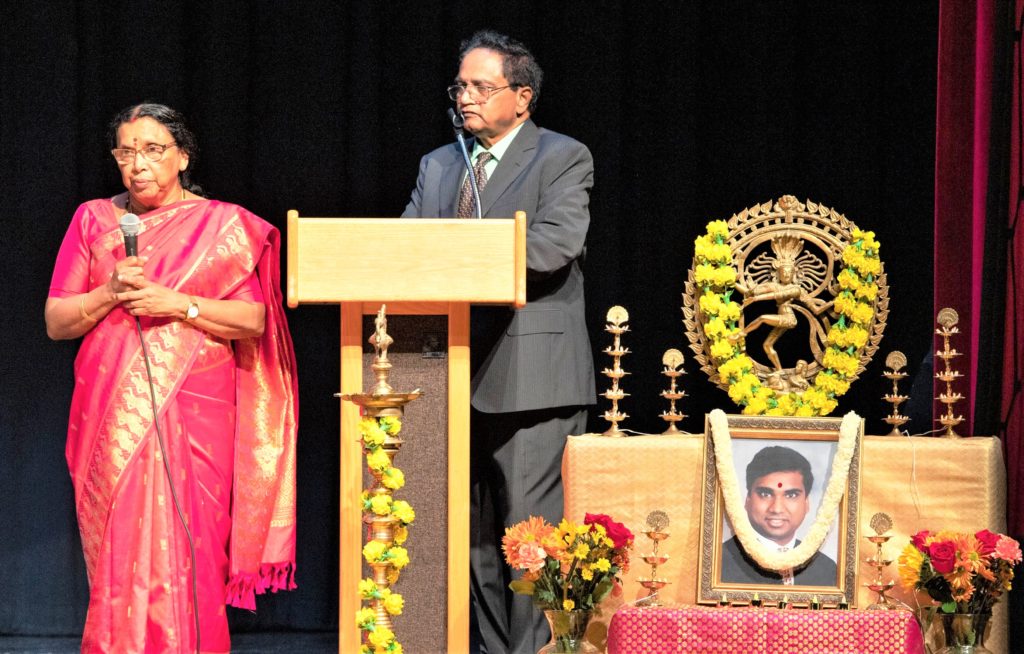
A few hundred people attended this day-long event, where more than ten dance and music schools from the greater Pittsburgh area show-cased the talents of their teachers and students.
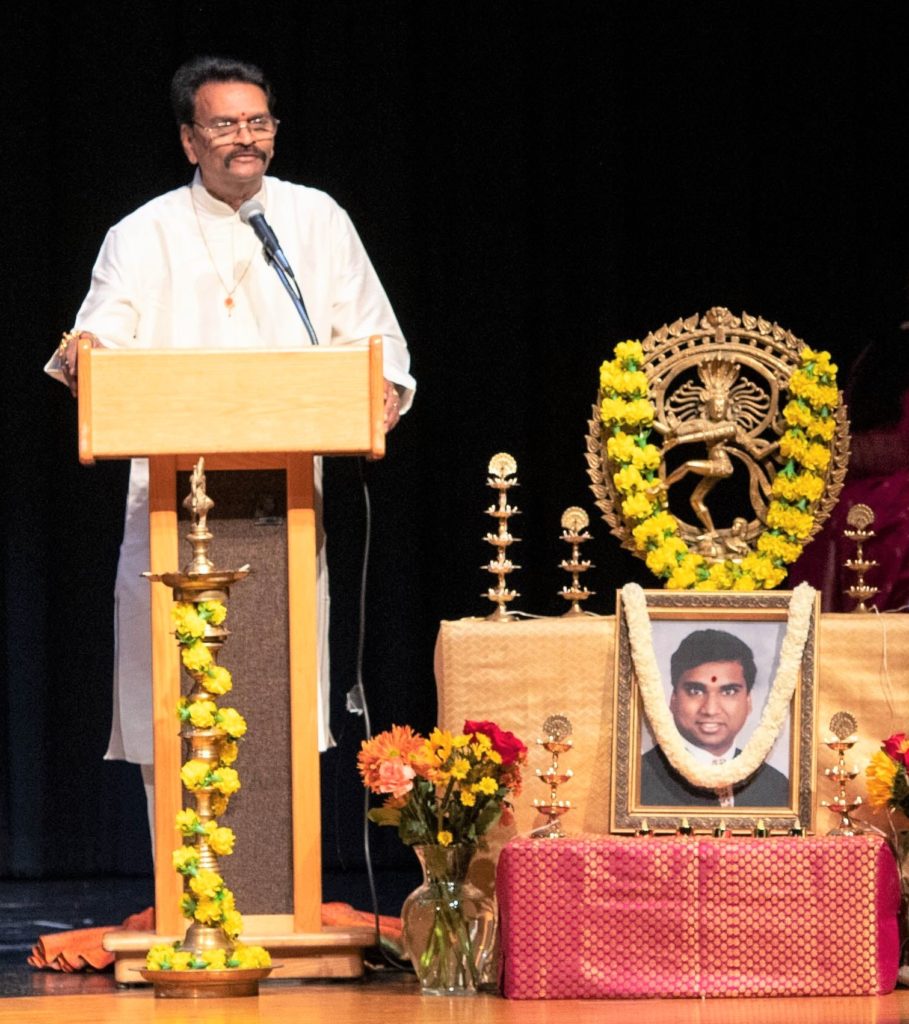
Inaugural session started with Deeparadhana and Invocational songs rendered by Sitalakshmi Madhavan, Saraswathi Chelluri, Sujana Mulukutla, Sheela Ganesh and Subha Sriram. They were accompanied by Shankar Krishnamurthy & Apoorva on violin, and Ganesh Iyer & Arjun on Mridangam. It was followed by Shri Varaprasad Gutti’s introduction of the Chief Guest for the event, Veena Vadya Vidya Visharada Sri Ayyagari Shyamasundaram from Andhra Pradesh, India. As part of the invocation session, Vasanta Krishna Lakkimsetty (Vasu’s niece) presented a touching Premanjali in the Kuchipudi style, memorializing Srinivasa Prasad Gutti. It certainly brought back several fond memories of Vasu to those who knew him.
In the forenoon session, artistic directors and students from Jaya Mani’s School of Bharatanatyam Dance (Director, Prof. Jaya Mani), Sitalakshmi Madhavan’s School of Karnatic Music (Director, Sitalakshmi Madhavan), SPIFPA School of Kuchipudi Dance (Director, Bindu Madhavi Gutti Rachuri), and Nandinik Dance Academy (Director, Nandini Mandal) presented their skills.
All the artistes and guests were treated to a sumptuous lunch during the mid-day break.
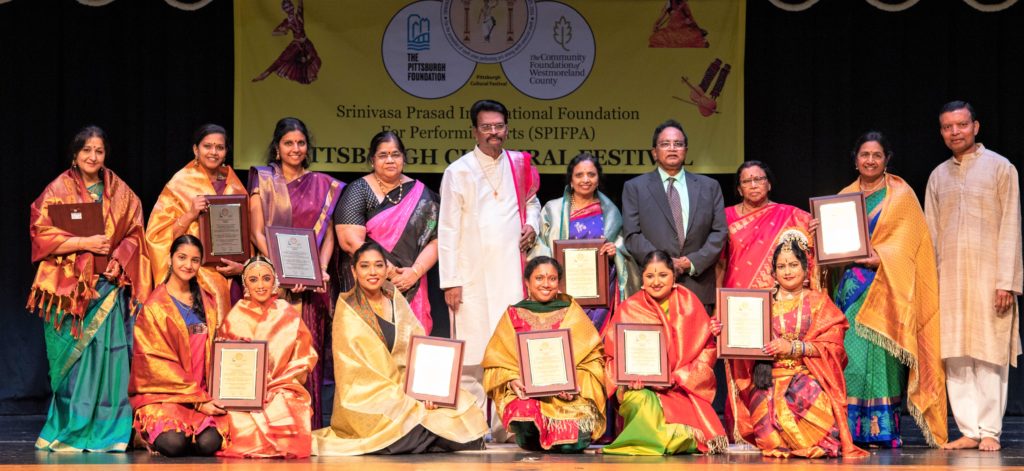
In the afternoon session, artistic directors and students from Natyakriya School of Bharatanatyam Dance (Director Shobhita Ravi), Sangeetha Saramaya School of Karnatic Music (Director Sujana Mulukutla), Sheela School of Carnatic Music (Director, Sheela Ganesh), University of Pittsburgh Team Pitt Nrityamala (Directors, Jothika Gorur & Nithya Kasibhatla), Courtyard Dancers of Kathak Nritta (Director, Niana Roychowdhury Green), Nritya Sumanjali Academy of Kuchipudi Dance (Director, Sumalatha Sri Ramoju) and Sanskruti School of Indian Dance and Music (Director, Shambhavi Desai) showcased their talents.
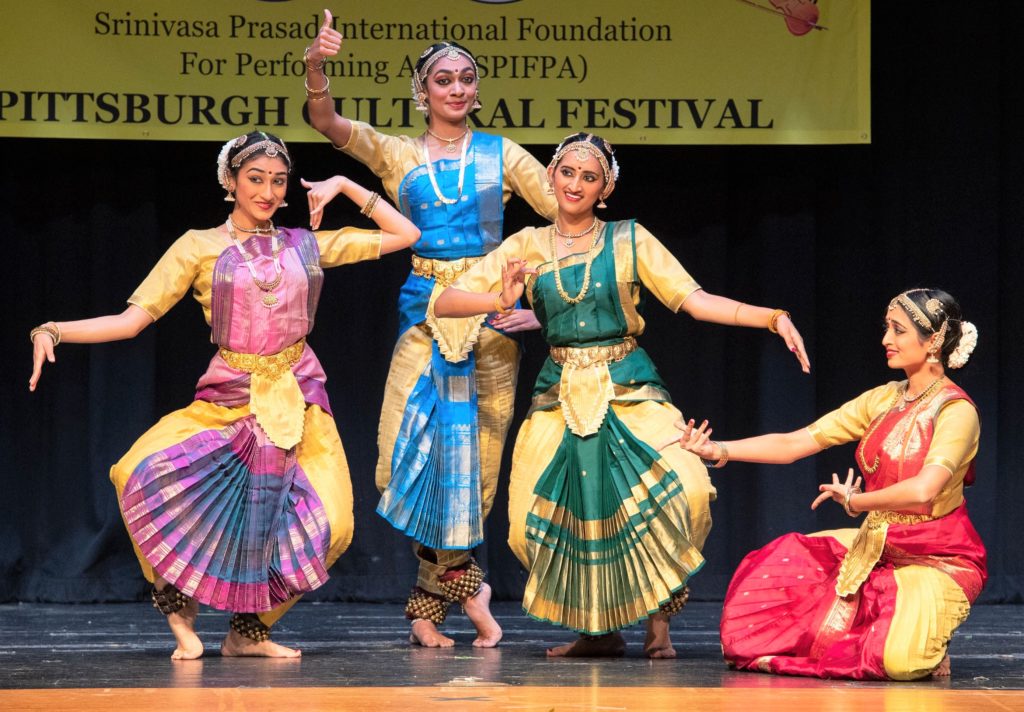
The highlight of the day was Sri and Smt. Gutti facilitating the Chief Guest Sri Ayyagari Shyamasundaram. Following the felicitation, Sri Shyamasundaram responded to the felicitation with a melodious veena recital which concluded the cultural program. SPIFPA honored all the gurus and artists that enriched the festival with their participation and presentations.
No doubt all the guests were treated to several Vindus or feasts (Vindu in Telugu and Virundu in Tamil) that day – Veenula Vindu (musical feast for the ears), Kannula Vindu (dance feast for the eyes), followed by a Vindu Bhojanam (grand Indian feast).
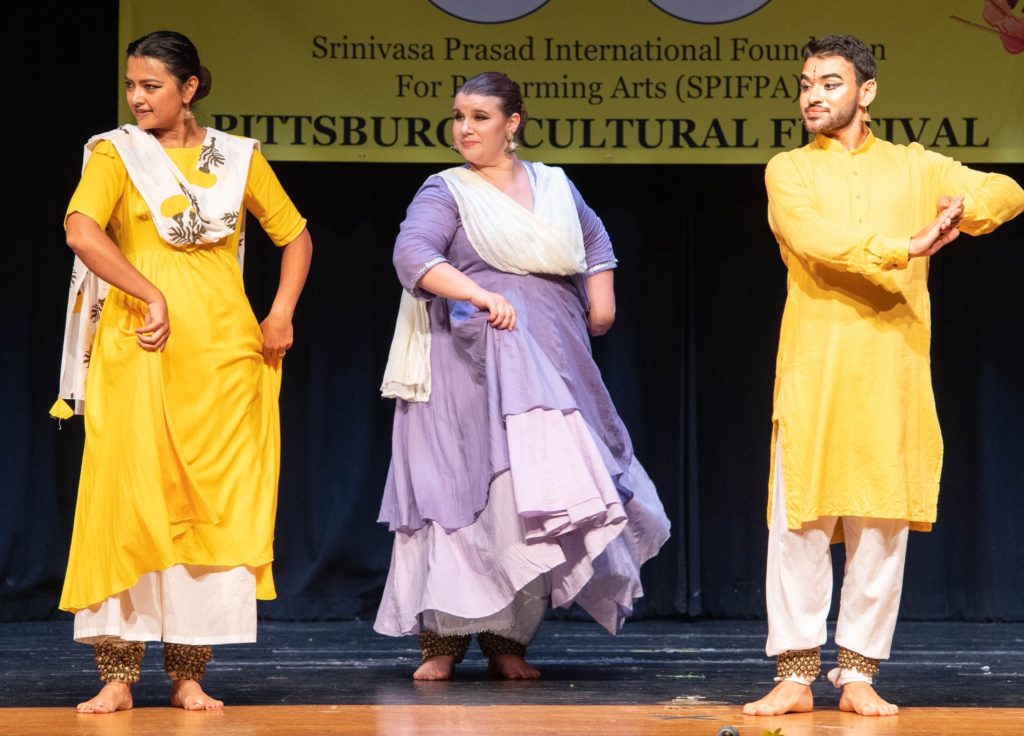
SPIFPA did a marvelous job in planning and executing this year’s program, which required lots of logistical details in managing the stage and lighting for all the different programs. I am happy to acknowledge the dedicated team of volunteers working on stage and back stage, taking care of all the needs of the artistes and guests. END ï®
Home:
Obituary: Om Sharma 1942 to Nov 1, 2019
Posted by admin in January 2020, Past issues on February 20, 2020
By Ramona Sahni, Pittsburgh, PA
Editor’s Note: Ramona Sahni is a long-time family friend of the Sharmas.
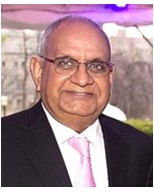
Om was born in Haryana, India on February 28, 1942 into a traditional Haryanvi family. He was the oldest of four siblings. His schooling was in Jaipur, Rajasthan, India followed by a degree in mechanical engineering from the University of Kashmir. This was followed years later by a master’s degree in mechanical engineering from the University of Pittsburgh.
Steel captivated Om. His first job was with a Birla company in Jaipur, where he worked for five years. During this time, he married Krishna in a traditional wedding and they had their three children: Sheeno, Mona, and Vickrant.
After installing a brand-new machine from Germany for the Birla company, he got an offer he couldn’t refuse from Tata Iron and Steel Works in Jamshedpur. After working there for eight years, in 1978, he saw that he had reached the ceiling for his career advancement.
The Sharmas immigrated to the United States in 1978. He had interviews in San Francisco, Detroit and Pittsburgh. Like some of us, while he was flying over the hills, valleys and rivers of our beautiful city, he felt a sense of home, remembering his young days in Kashmir. So here he was, from one steel city in India to another steel city in the United States! The Sharmas have stayed here ever since.
He started with Pennsylvania Engineering and later worked at Westinghouse. In 1983, he took a leap of faith and went into the steel business for himself. He founded Sherman International dealing with various aspects of steel, doing business across the globe.
He enjoyed music, poetry and singing. He always had a joke to tell, especially Haryanvi jokes. He had a passion for life, living each day to its fullest. He and Krishna travelled extensively, often to my amazement and concern, when he admitted he was being eaten within by his disease. Such was his courage and fortitude!
Om was an adoring father, willing to spend the night standing in line to buy coveted concert tickets for his young daughters. He was a doting husband who loved to sing “jo tum ko ho pasand, wohi baat kahenge, tum din ko kaho raat to raat kahenge†to his wife Krishna of over 50 years!
When I asked one of his long-term friends what he liked most about Om, he said, it was his genuineness. This was attested to by a number of people who attended his funeral on November 3, and by the daily satsangs held at his home, culminating in the traditional pagadi rasam, held 13 days later, at the Indian Community Center in Carnegie, which he helped establish.
A man is remembered by the legacy he leaves behind. Om will be remembered not so much for building a successful business or for his charitable contributions to the Hindu Jain Temple, The Encyclopedia of Hinduism, or to institutions like our own Phipps Conservatory, but for the place he carved for himself in the hearts of friends like me.
Pandit Suresh Chandra Joshi from the Hindu Jain Temple conducted the Vedic cremation for Om Sharma on November 3, helping Vickrant, Mr. Sharma’s son, with the cremation rites at the Beinhauer Family Funeral Home, Pittsburgh. Om Sharma is survived by his wife, Krishnaa, all three of his siblings, three children and six very talented grandchildren. END ï®
Home:
My Mataji’s (Mom’s) Kitchen
Posted by admin in January 2020, Past issues on February 20, 2020
By Juginder Luthra, Weirton, WV
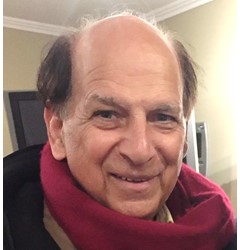
Each one of us gulped down the butter covered fresh rotis with steaming sabzi (cooked vegetable dishes) coming out of the kali covered brass kadaai (wok), lovingly served with mataji’s strong hands and loving eyes. The smile in the eyes matched the one on her full lips.
“Do you have more gobhi?”, even though the rotis were delicious enough alone and the answer was always “yes”. Gobhi is cauliflower in north Indian languages.
We did hear the ladle scraping the walls of the kadaai, which got quickly shielded by a metal cover with a small handle in the middle, which she held with the outstretched end of white sari.
“Eat, there is plenty more,â” she would say. We suspected it to be a lie, but the empty stomachs and young minds were too selfish to worry about her. And she loved our selfishness.
“Toon changa khada mainun aape mil gaya.” I remember her telling us in Punjabi, our mother tongue. “You ate well, it got to me automatically.”
Later, with a satisfied look in those loving eyes surrounded by wrinkles of worries and joy, she took two dry rotis, rubbed them on the katori (a small cup for serving dishes in dinner) which just a few moments ago was overflowing with the home-made white butter she made before the sunrise that morning by churning the home-made dahi (yoghurt).
Placing the rotis on a small steel plate, she crushed a small oval red onion between her two hardened palms, which, years ago, were softer than rose petals. The smaller onions were not pungent, especially the oval central core of the tender ones, unlike the larger ones, which are hard to crush and make your eyes tear. These were not as delicious.
“Somehow onions and humans are not much different,” she occasionally mentioned stoically.
She then pulled out a couple of dripping mango achaar (pickle) slices, also home-made, from the tall pale ceramic jar. Now, with the satisfaction of having nourished her family with food and love, she sat on the cloth woven chauki (a small low-height stool), folded her legs and put the plate on her knees. She scraped the few burkis (roti pieces) along the side of kadai till she could see the shiny walls of the kadai. The rest was enjoyed, relishing it with raw onion and achaar. She ate alone, in peace.
Her husband, our pitaji (dad), also was eating alone in some remote place working in a brick kiln; making barely enough money for his family to survive, helpless victims of the monstrous problems arising out of the 1947 Partition, in which the British in great haste slit India into India and Pakistan, causing misery and mayhem for millions in the Indian subcontinent, thus transforming a prosperous farmer in Pakistani Punjab into a brick maker near Delhi, and a well-to-do family into refugees overnight.
Mataji held the fort at home. With her family safe, well nourished with love and her food, she was content and happy in her kitchen. END
Home:
Mahatma Gandhi’s 150th Birthday
Posted by admin in January 2020, Past issues on February 20, 2020
By Antara Cleetus, South Hills, PA

Note: An 11th grader at Upper St. Clair High School, Antara Cleetus is a classical singer and dancer, and an occasional writer and painter. A member of her school’s speech and debate team, Antara believes in the power of words: spoken, sung, and written.
In 2009, former President Barack Obama was asked by a 9th grader, “Who would you most like to have dinner with, dead or alive?†Obama responded, “Gandhi, who’s a real hero of mine.†He also joked, “It would be a really small meal.â€
Nearly 100 years separate the births of these two leaders. Their homes, nearly 7,000 miles apart. Yet, none of this matters in light of Mahatma Gandhi’s global, powerful, and timeless reach. This anecdote related by the emcee, Maneesha Kumar-Cleetus, set the tone for the evening and captured the essence of not just a man, but the legend, Mahatma Gandhi.
Mahatma Gandhi’s 150th Birth Anniversary was commemorated on Sunday, October 6, 2019 at the University of Pittsburgh’s Frick Fine Arts Auditorium. The anniversary was not just celebrating the man himself, but his enduring legacy. The evening, filled with a sense of unity, bridging gaps between all backgrounds — religions and cultures — featured speakers, interfaith presentations, cultural performances, and student readings.
Chief Guest for the event, the Consul General of India, New York, Mr. Sandeep Chakravorty, spoke of the relevance of Gandhi today, in the wake of the global warming crisis. It’s a facet of the Mahatma that often gets forgotten. Everyone knows the pacifist Gandhi but not the ecological Gandhi. Reading excerpts from his writing, “The Ecological Mahatma,†Mr. Chakravorty encouraged his audience to apply Gandhi’s ideas to solve today’s problems.
He then unveiled the new bronze bust of Gandhi, which will be permanently installed in the University of Pittsburgh’s Oakland campus Hillman Library. The majesty of the statue resulted in immediate applause. This reaction was as much for the beauty of the bust as for the legacy that it embodied.
The interfaith presentations shared during the program included teachings from Christianity, Hinduism, Sikhism, Buddhism, Baha’i, and Judaism. In fact, within the religious presentations, the spirit of Gandhi came alive. Reverend Rodney Lyde spoke on Christianity and stated that Gandhi’s remembrance “was not a dead memorialization, but a living faith.†Sanjay Mehta, representing the Hindu community, added that “Gandhi doesn’t go where peace is, rather peace comes with him.â€
In addition, artistic performances by Shrabani Basudev, Nandini Bhowmik, and Nandini Mandal graced the stage like poetry in motion. In twirling silk saris and stripes of green, white, and saffron, Nandanik Dance Troupe recreated the Indian Flag. Gandhi’s favorite hymn, Vaishnava Jana To Tene Kahiye, was sung with emotion and fervor by Manju Germanwala, filling the auditorium and the hearts of the audience. Out artist — Francis Cleetus — created a piece of 3D art depicting Gandhi’s profile with one piece of rope, symbolic of the single cotton strand Gandhi used to spin on his charkha.
Reverend DeNeice Welch highlighted Gandhi’s influence on Martin Luther King Jr. during the Civil Rights Movement. She posed the question, “How can I speak about MLK without speaking of Gandhi’s influence on MLK?â€. Simply put in Reverend Welch’s words, “These two brown men did an awful lot to change this world.â€
The 150th year celebration had the perfect finale. Little tea lights passed on the message for spreading goodwill and peace. Rabbi Jamie Gibson led the presenters and audience alike to sing “Let There Be Peace on Earth.†Among the joined hands, soft laughs, and full smiles, it became evident that Gandhi’s message still lives on. We left the auditorium with a final quote by Gandhi ringing in our ears: “It is my conviction that nothing enduring can be built on violence.†It’s a thought that’s as relevant in 2019 as it was a century ago.
Editor’s note: The renowned sculptor Ram V. Sutar, now in his nineties, created the bronze bust of Gandhi dedicated at the ceremony. He has mastery in realistic sculptures and has been recognized by various countries and artists from all over the world. For more info, go to www.ramsutar.in END
Home:
Why This Issue is Coming Late?
Posted by admin in January 2020, Past issues on February 20, 2020
By Premlata and Kollengode Venkataraman
For the past twenty-five years we have been publishing the Pittsburgh Patrika without missing our own self-imposed deadlines. When we started the magazine, we were parents of two teenage daughters and were agonizing over our aging parents in India. And we brought out the magazine every three months, working on this in our spare time while holding onto our full-time jobs that involved frequent work-related travels.
We managed to keep our publication schedules through the graduations of our daughters, their weddings, and the birth of our grandchildren. Even more so, through the prolonged Final Exits of our beloved parents.
But this January issue is delayed by a month in spite of our best efforts. To prove the adage that life happens as we make plans for it, events just happened. Just as we were getting ready during the Thanksgiving holidays to put together our December issue, we were presented with retirement options at work, with the rider that we should make our decisions in two weeks. Weighing our options occupied all our attention in November through January, even though we were preparing to make this transition on our own towards the end of 2020.
Our situation was compounded by our month-long trip to India in December with our daughters, their husbands and our grandchildren, which was planned in late summer. This travel coming right in the midst of the festival season in India overwhelmed us with decisions that left little time to finish up the magazine before we left for India.
Both of us are now retired as of January 2020, after all the excitements of completing paperwork, handing over responsibilities, farewell parties and bidding goodbye to a lifetime of relationships at work.
In this new climate, we are re-dedicating ourselves to keep publishing The Pittsburgh Patrika as long as our readers expect us to do, and our advertisers support us for paying the bills.
As always, your participation with writing articles and helping us in any way possible will help us keep the magazine coming to you without fail and with no cost to you. Looking forward to bring more exciting issues ahead. END ï®
Home:
Dhru & Gul Bhagwanani Indian Senior Center A New Path for Pittsburgh’s Indian Community
Posted by admin in January 2020, Past issues on February 20, 2020
By P. J. Gursahaney, Wexford, PA
Editor’s Note: P.J.Gursahaney, a retired executive at Electrolux International, has been active in the Indian community. He and twelve other families were actively involved in 1980 to open the first Sunday school in Pittsburgh to teach our kids Hindi and expose them to the Indian culture.
On Friday, November 15 last year the Bhagwanani Indian Senior Center was inaugurated in Monroeville, providing a new beginning for Pittsburgh’s Indian senior citizens. The center is located at 3946 on Business Rt 22 in Monroeville, right behind the Sheetz Gas Station. The center has an inspiring beginning.

Dhrupadi and Gul Bhagwanani, residents of O’Hara Township, were low-key and well-known to many in the Indian Diaspora. They participated in many social, cultural and religious events organized here. People would have have seen them in the Hindu-Jain Temple, the Gurudwara, the S.V. Temple, and in the Ramakrishna and Chinmaya Missions’ lectures.
Both Dhrupadi and Gul were “children of Partition.†They reached India in 1947 with their parents, as refugees from Pakistan, during the violent and badly managed Partition of India by the British. Partition uprooted the lives of millions and forced them to re-start from scratch. (Read Juginder Luthra’s story on Mataji’s Kitchen in this issue). Growing up in India, Dhrupadi went to medical school and Gul earned his accountant degree in India. They arrived in Pittsburgh in the ‘70s via Canada — Dhrupadi as a radiologist at West Penn and Gul aa a CPA.
The Bhagwananis passed away in 2012 — he in February, and she in April, just two months apart. They had no children. In their later years they felt lonely and experienced the need for a senior center where seniors can meet and socially interact with each other. Before their deaths, in early 2012, they formed a tax-exempt entity, naming it “Dhru Gul Bhagwanani Pittsburgh Indian Senior Center,†approved by the government under section 501(C)-3 of the Internal Revenue code effective Feb 3, 2012, with a tax Id # 45-4528943.
Subsequent to their deaths, the Orphans Court of Allegheny County took control of their significant estate to distribute their assets according to their will, with Jamnadas (Jay) Thakkar as the Executor. The court decided on the Dhru Gul Bhagwanani Pittsburgh Senior Center in June 2014, appointing Thakkar as the Executor or Trustee, stating that Thakkar “shall receive no compensation for this service,†which he was happy to do for his friends, the Bhagwananis.
In 2016, upon the recommendation of Thakkar, the court gave approal for a two-member committee to form the board of trustees (to be selected from among the Indian organizations) for independently running the Bhagwanani Indian Senior Center. The groups identified for forming the board were members in the Hindu Jain Temple, the SV Temple, the Gurudwara, the Gujarati Samaj, the Jain Community, the Sindhi Community, the Punjabi community, North & South Indian communities, and the Indian Cultural Association of Pittsburgh.
The court in 2017 approved the bylaws for the organization and appointed the board members: Dr Radheshyam Agrawal as its president; and the assets to be managed by the treasurer Mr. P.J.Gursahaney. Other board members are Mr. Kishor Mehta (Secretary), Mr. Satish Jindal (Board Member). Other additional Advisory Board members: Mr. Rahul Joshi, Dr. Mohan Chabra, Mr. Prabhanand Yedla, Dr. Praful Desai, Dr. Datar Singh, Mr. Mahendra Shah & Mrs. Mira Shah.
The court order also stated that a) The Board is expected to develop appropriate programs for the use of incomes generated from the Bhagwanani estate funds & its investments, and b) The Senior Center shall also “file an annual report of its finance and activities with the office of Attorney General and shall make copies of the annual reports from financial institutions available for the office of the Attorney General.â€
During the dedication ceremony on November 15, 2019, Dr. Radheshyam Agrawal acknowledged the Bhagwananis for their generosity, foresight and vision for having a senior center, even though they themselves did not see their dream fulfilled. He also acknowledge Jay Thakkar for getting this job done patiently and relentlessly working on this for several years. The center is geared to provide activities that result in better physical and emotiional/mental health.
Dr Mohan Chabra, while addressing the audience, said the mission of the Center is to add quality to our ageing years by providing recreational, educational, spiritual and wellness activities. There will be yoga and exercise activities and educational seminars on different topics, including health matters, taxes, and nutrition, Dr. Chabra said.
Currently, the center is open on Saturdays and Sundays between 11:30 am and 3:30 pm with access to cardiac exercise machines, with provisions for indoor games, karaoke, and movies. Also available are a lecture hall with a podium and chairs for PowerPoint/video presentations, a kitchenette facility, and an open room for yoga classes.
Anybody over 60 can attend the events for free at the center. As per the wishes of the Bhagwananis, the facility will be operated alcohol-free, smoke-free, and only vegetarian food will be served within the premises. Current phone number at the center is 412.837.4055. For additional details contact pittsburghisc@gmail.com or visit the website www.iscpittsburgh.org.
Pandit Suresh Chandra Joshi led the brief religious ceremony dedicating the place to the public.
For the present, the facility is on the first floor of the building. But when the leases end with the the current occupants of the ground floor, the Senior Center will be moved to the ground floor. END ï®

